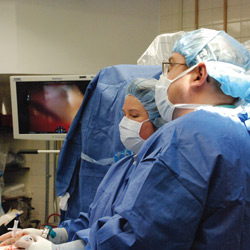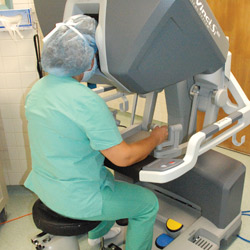
Three-dimensional color images illuminate the viewfinder as a surgeon delicately maneuvers four robotic arms a few feet from the surgical operating table. It may sound like something out of a science fiction movie, but it’s actually one of the high-tech surgical procedures performed at Methodist Medical Center.
Paul Killinger of Peoria is observing his fifth anniversary after receiving robotic surgery in May of 2005 as the first patient for Methodist’s da Vinci Robotic Surgical System. Killinger, then-CEO of SC2 Supply Chain Service Company, had a family history of prostate cancer, so when his physician noted an increase in Killinger’s PSA blood test, a biopsy was ordered.
“My numbers really were not that high, but since they had increased, and with my family history, my doctor felt it was prudent to get a biopsy. Turned out he was right,” Killinger said. The biopsy indicated the presence of cancer, and the prospect of surgery caused Killinger to begin researching treatment options and outcomes. “I went to the Internet and found information about the da Vinci robotic surgery system and then started checking to see if robotic surgery was available locally.” Killinger continued, “I learned through my surgeon that Methodist had just had a system installed and as it turned out, I was the first patient to use it.”
Over the last five years, with several equipment upgrades, robotic surgery has become a regular part of the surgical services at Methodist. Robotic surgery is locally available for a number of procedures, including cardiology, general surgical procedures, urology and gynecology. The da Vinci system is a sophisticated robotic platform designed to enable complex surgery using a minimally invasive approach.
Minimally invasive surgery is performed through dime-sized incisions, called operating ports. This is in contrast to the much larger incisions used in traditional open surgery, which are often as large as six to 12 inches long. Using the da Vinci system, the surgeon operates while seated comfortably at a console viewing a 3D image of the surgical site while manipulating four remote surgical arms. The system seamlessly translates the surgeon’s hand, wrist and finger movements into precise, real-time movements of surgical instruments inside the patient.
 Many surgical procedures performed today using standard laparoscopic techniques may be performed more quickly and easily using the robotic system. Jeanine Spain, vice president of Patient Services at Methodist, says, “By enhancing surgical capabilities, the robotic system helps to improve clinical outcomes and redefine standards of care. Patients of robotic surgery generally experience an impressive list of significant advantages, including reduced trauma to the body, reduced blood loss and need for transfusions, less postoperative pain and discomfort, less risk of infection, shorter hospital stays, faster recovery and return to normal daily activities, and less scarring.”
Many surgical procedures performed today using standard laparoscopic techniques may be performed more quickly and easily using the robotic system. Jeanine Spain, vice president of Patient Services at Methodist, says, “By enhancing surgical capabilities, the robotic system helps to improve clinical outcomes and redefine standards of care. Patients of robotic surgery generally experience an impressive list of significant advantages, including reduced trauma to the body, reduced blood loss and need for transfusions, less postoperative pain and discomfort, less risk of infection, shorter hospital stays, faster recovery and return to normal daily activities, and less scarring.”
“For the physician,” according to Spain, “benefits include greater surgical precision, increased range of motion, improved dexterity, enhanced visualization and improved access.” The surgeon operates from a comfortable seated position at a console, with eyes and hands positioned in line with the instruments. To move the instruments or to reposition the camera, the surgeon simply moves his or her hands.
Paul Killinger is a firm believer in robotic surgery. “I was back to work in only two weeks following my surgery and I experienced all the benefits promised by proponents of the robotic systems.” He and his wife now volunteer for the cancer society helping to educate and support fellow cancer patients.
Needless to say, this revolutionary robotic technology has unlocked a potential that until recently has only existed in fictional tales. With medical robots such as the da Vinci system, medical knowledge has expanded to new heights, which can only improve the quality of living for countless individuals. iBi

